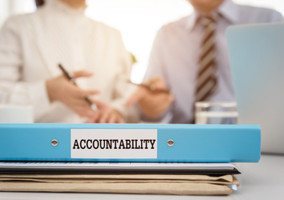The inaugural Charity Finance Week took place earlier this month. At one event I was asked a question: if you were to scrap the charity annual report and accounts, and start again with a blank sheet of paper, what would you do?
It’s safe to say that it wouldn’t look like what we’ve got. And your answer might be very different from mine. But I would start by asking what the purpose of charities was.
Of course, the answer is they are there to do good – to deliver public benefit. That is why they get tax breaks, and have a special legal form, and why people give them money and ask nothing in return.
So it might make sense to start by asking charities to account for how they are delivering that good. Surely that should be the focus of statutory reporting?
Of course, when it comes to charity accounts, we haven’t got a blank sheet of paper. Charity accounts are highly regulated and standardise. They have to be so, because they need to dovetail with company law, and people have to be able to read them. So they have to look like company accounts - and each other.
But in front of the annual accounts, each year, charities are required to include another document - the annual report. And here, at least, they do have some flexibility. Not only that, but the SORP requires them to explain their activities and how they achieve their aims. Yet too often, the annual report gets filled with waffle.
I would suggest that there’s a concrete role for the annual report, and it is to answer this fundamental question: what good do you do?
There's already a legal requirement to answer this question - the public benefit statement, which already has to be in every charity annual report. At the moment it's often a meaningless boilerplate, but it should be the most important item in the whole document.
What are you here for?
Perhaps the place to start, when formulating a public benefit statement, might be by asking who you’re trying to help, and what they need. After all, people need to understand that before anything else makes sense.
Then we might ask how you plan to deliver on your goal. What activities will deliver success for your beneficiaries? Why did you choose your particular interventions?
Then we could ask how you, the charity, measure your own success. What are the six or eight or ten metrics which you use as your own dashboard? And then, how do you perform against those metrics? How did you do against them last year? How did you do this year? What do you plan to achieve next year?
Obviously, each charity’s answers would be different. Each needs to look to its own beneficiaries and its own actions.
What’s absolutely vital - and what's missing now from even the better ones - is that the information can be audited, it can be compared with previous and future years, and it’s tied to your charitable objectives.
If you want to see what I'm talking about, check out Clic Sargent's impact report. I'm not sure why this report isn't incorporated into the charity's annual report and accounts, or why it's quite so well hidden on the website. And I'd like a bit more long-term comparability. But I'm just being picky. It's great.
I can’t help feeling that a decade or so ago, when public benefit reporting was mandated in charity accounts, this was more or less what the Charity Commission was hoping for. I also think that when the campaign for charities to measure impact began, this is what it wanted.
My feeling is that this should be more or less the first item in an annual report, straight after the chair's introduction.
All the other parts of the annual report - risk register, fundraising report, key achievements - effectively become notes to the strategy and public benefit statement.
But what about money?
None of the above mentions money. Which is right, because charities are about people first, not money. So that's where we should start. But we do need to think about the money, too.
We already have annual accounts to assess your financial probity. A benefit report needs to look at how your money helps your mission.
For me, the key questions are:
- How much money did you spend on helping people?
- What did you spend it on?
- Do you have the money in the bank to do what you need to do next year?
What isn’t in this list is a single-year fluctuation in reserves - otherwise known as profit - because it is not significant, really. You would expect a charity to spend more than it receives almost as often as not.
Instead the real financial bottom line in our benefit report is the free reserves. That’s the figure that allows you to be sure you can continue to deliver benefit.
Forecasting
Ideally, another factor in our benefit report would be some long-term assessment. Charitable activities aren’t delivered over a single year.
The exact time frame will depend on the charity, but broadly the question is really what’s been happening over the last decade, and what you think will be needed over the next one. If you are trying to produce generational change, you should report over generational horizons, too.
Of course, it's also worth bearing in mind that guesses about the future are usually wrong, and that being wrong only really matters if the guesses are consistently wrong in one direction; if you constantly find yourself overspending or underspending against your projections, you need a new model.
The key thing is that we know where the charity has come from and where it’s going.
What's better about this model?
There are a few reasons, I think, to do things this way. One is that it’s already mandated by law. Charities have to report on their public benefit, but mostly they do so using relatively boilerplate statements - or not at all. So this is simply a better way of approaching an existing requirement.
Another is that it gives a clear structure to the annual report, which is often longer on words and shorter on information than is really required.
A third reason is that it speaks to a key theme at present: public trust.
It would be naive, at best, to suggest that the public read charity accounts. Nonetheless, those accounts are the primary accountability tool for many charities, and we should try to use them to engender trust.
This trust narrative is clearly a priority for the chair of the Charity Commission, and while I do not agree with everything Baroness Stowell has to say on that subject, it is a challenge worth taking up.
The public have two questions, really: are you ethical and are you effective? My experience is that charities don’t try terribly hard to answer either of these questions honestly. A public benefit approach would do so.
A fourth reason is that it more effectively tackles the issue of impact. Public benefit, as described and measured above, is synonymous with impact. Charities have tended to spend a lot of time on producing impact reports, but they’ve often not been internalised into the processes of the organisation, and they’ve sometimes been too focused on funders, and too complex to easily understand. Starting again with public benefit gives us a chance to get it right this time.
Finally, all of the above has the potential to offer a clear model for governance. The three main requirements of a governance function are strategy, scrutiny and support. The model above suggests a fairly logical cycle to this process. Set the strategy, support its delivery, and then scrutinise your progress. Use the feedback to set a new strategy.
So I think there’s a lot to recommend this approach. It helps everyone understand why your charity exists, it enables an honest conversation about success, and it helps you plan for the long term.
And it should hopefully make the TAR shorter, too.
|
Related articles












